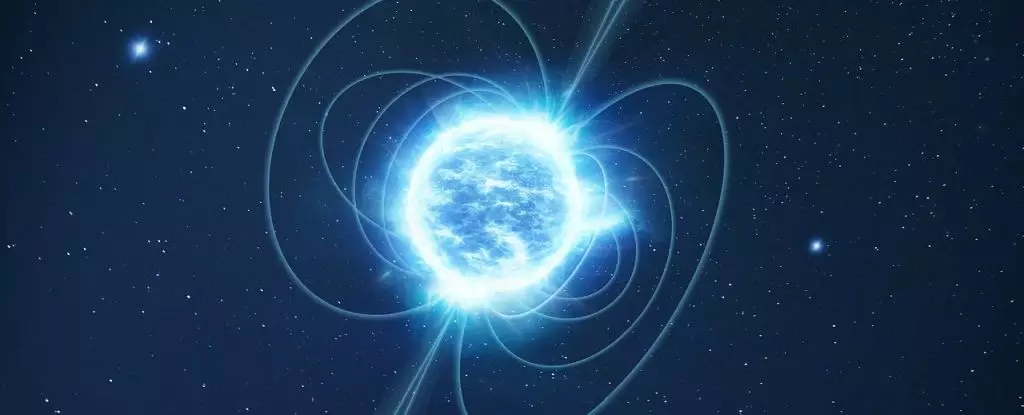In the depths of our galaxy, a peculiar neutron star known as SGR 0501+4516 has captured the attention of astronomers, shedding light on the mysterious formation of magnetars. These extraordinary celestial objects defy our conventional understanding of stellar evolution. They are not just denser than typical stars; their magnetic fields are the strongest known in the universe—thousands of times more powerful than those of regular neutron stars. Yet, the mechanisms that give rise to such intensely magnetic entities remain shrouded in doubt.
Recent observations using the Hubble Space Telescope and the Gaia mission have put the traditional narrative of magnetar formation under scrutiny. Hitherto, it was widely accepted that magnetars like SGR 0501+4516 were born from core-collapse supernovae, a process where massive stars exhaust their nuclear fuel and succumb to gravitational collapse. However, this prevailing theory now appears increasingly tenuous as the data from these prestigious telescopes imply a different origin story for SGR 0501+4516.
A Surprising Disconnect from Supernovae
For years, astronomers believed they had located the developmental cradle of SGR 0501+4516 due to its proximity to the supernova remnant HB9. The assumption was straightforward: if SGR 0501+4516 resides near this remnant, surely it must have emerged from a supernova event in a correlated manner. However, the recent precision measurements have disrupted this narrative. The findings reveal that the motion of SGR 0501+4516 is inconsistent with an association to HB9, thereby raising more questions than answers.
The data analyzed by astronomer Ashley Chrimes and her team indicate that the magnetar is moving away from the supposed supernova remnant with a velocity that challenges the assumption of a shared history. Additionally, the absence of other neutron stars in the neglected vicinity further complicates determining SGR 0501+4516’s origins. Such revelations suggest that we may need to reassess our understanding of magnetars entirely.
Understanding Neutron Stars and Magnetars
At their core, neutron stars are remnants left behind after massive stars undergo supernova explosions. They exemplify some of the universe’s densest forms of matter, where the collapse of a star compresses its core into a state dense enough that protons and electrons combine to form neutrons. This process normally leaves behind a neutron star; however, when conditions are right, it leads to the formation of a magnetar. The immense magnetic fields generated by these celestial bodies arise from the rapid spinning and intricate dynamics of their dense cores.
Yet, the concept of a magnetar’s birth from a traditional supernova has become increasingly questionable. The two-pronged hypothesis now suggests that SGR 0501+4516 might have either outlived its associated supernova remnant or been produced through an entirely different mechanism altogether, such as the merger of two neutron stars or a white dwarf collapsing into a neutron star under specific conditions.
Considering Alternative Pathways
The prospect of a white dwarf being involved in the birth of SGR 0501+4516 injects exciting possibilities into the mix. White dwarfs are remnants of low-mass stars, typically rich in mass from binary companions. In a theoretical scenario, if such a white dwarf accumulates an excessive amount of matter, it could reach a tipping point that allows it to collapse into a neutron star rather than exploding as a supernova.
This alternative pathway for the formation of SGR 0501+4516 not only highlights the complexity of stellar evolution but also emphasizes the diversity of processes that can lead to these intriguing objects. It opens new avenues of investigation regarding the lifecycle of stars, especially in binary systems. If confirmed, such pathways could change the landscape of our understanding of how magnetars come into being and the conditions necessary for their formation.
A Paradigm Shift in Stellar Astrophysics
The implications of the findings regarding SGR 0501+4516 extend well beyond the mystique of the magnetar itself. The specter of uncertainty looms over our understanding of neutron star evolution and formation. While many questions remain unanswered, there lies an exhilarating potential for groundbreaking discoveries that could reshape the field of astrophysics and our understanding of the cosmic landscape.
As researchers continue to unravel the complexities surrounding magnetars, every new piece of data brings a wave of excitement and curiosity. The journey of exploring the cosmos is rife with unexpected twists, such as those presented by SGR 0501+4516. Humanity’s quest for knowledge about the universe has a long way to go, and as we gaze at the stars, there are still countless mysteries awaiting discovery, with magnetars standing at the forefront of this celestial intrigue. Each revelation not only expands our comprehension of stellar evolution but also deepens our sense of wonder about the universe itself.

